The breakthrough of the Neysen border by the troops of the 1 of the Ukrainian Front
The overall objective of the 1 Ukrainian Front operation under the command of Marshal Ivan Stepanovich Konev was to break through the German defenses on the Neisse River, defeat the enemy groups in the Cottbus area and south of Berlin, followed by the advance to the west and the Soviet troops entering the Belitz, Wittenberg and R. Elba.
By the beginning of the operation of the 1, the Ukrainian front turned south of the 1 of the Byelorussian Front in an area of width 390 km from Gross-Gastrose to Krnov. The main shock grouping of the front was located on the 48-kilometer stretch of Gross-Gastrose, Birkfer. The Birkfer site, Rotenburg in 30 km was defended by two Polish divisions. The southern auxiliary shock group was located on the 13-kilometer stretch of Rothenburg, Penzich. The Penzich, Krnov sector (about 300 km) was defended by divisions of the left flank of the 52 army, troops of the 21 and 59 armies. The 6 Army continued the siege of Breslau. Already during the Berlin operation, the 31 Army was deployed to the left flank of the front.
Konev decided to strike the main blow with the forces of three combined arms and two tank armies from the Triebel area in the direction of Spremberg, Belzig in order to defeat the German troops in the Cottbus area and south of Berlin and the front to reach the r. Elbe. The right wing of the front was to take part in the storming of Berlin. The main strike group consisted of the 3rd Guards Army of Vasily Gordov, the 13th Army of Nikolai Pukhov, the 5th Guards Army of Alexei Zhadov, the 3rd Guards Tank Army of Pavel Rybalko and the 4th Guards Tank Army of Dmitry Lelyushenko. The 3rd Guards Army was reinforced by the 25th Panzer Corps, and the 5th Guards Army by the 4th Guards Tank Corps. In addition, in the second echelon of the front was the 28th Army of Alexander Lucinschi, which was supposed to build on the success in the main direction. On the second day of the operation, the main strike grouping of the front was supposed to break through the enemy's defenses in the Forst-Muskau sector and reach the Spree River.
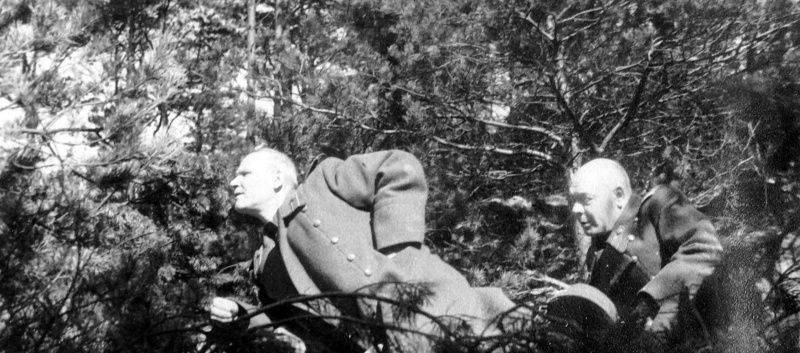
The commander of the 1-th Ukrainian Front, Marshal I.S. Konev and the commander of the 4 Tank Army DD Lelyushenko at the observation post at the breakthrough of the German defense on the river Neisse
From the line of the river Spree, they planned to enter into a breakthrough tank armies (in reality, they entered the battle on the first day of the operation). Army Rybalko received the task of advancing from the line south of Cottbus, and the army of Lelyushenko - from the area north of Spremberg. The mobile units of the front were to decisively break away from the front and develop a rapid offensive to the north-west, in the general direction of Troyenbritzen. Guards Army Rybalko received the task on the 5-th day of the offensive to go to the area of Trebbin, Troyenbritzen, Lukenwalde, on the 6-th day - to capture Brandenburg. Part of the forces 3-th Guards Tank Army received the task of attacking Berlin from the south. Guards Army Lelushenko received the task on the 5-th day of the operation to go to the area Nimegk, Wittenberg, and on the 6-th day - advanced troops to take Rathenov and Dessau.
To ensure the success of the main attack force from the south, the 2 Army of the Polish Army Karol Sverchevsky, the Polish Tank Corps and the right wing of the 52 Army Konstantin Koroteyev with the 7 Guards Mechanized Corps of Ivan Korchagin from the area west of Colfurt in the general direction of Dresden. In addition, in the offensive zone of the 52 Army, they planned to introduce the 1 Guards Cavalry Corps of Viktor Baranov. The cavalry was supposed to go into the rear of the enemy's gertzyk-Dresden grouping. From the air, the attack of the 1 of the Ukrainian Front was supported by Stepan Krasovsky's 2-I Air Army.
Neissen Breakthrough
16 April. On the night of April 16 1945, in the Forst, Muskau, our troops conducted reconnaissance by force. From each division, the first echelon was allocated to a reinforced company. At night, reconnaissance companies, reinforced by gunners and mortar guns, covertly forced Neisse. However, their attempts to penetrate the enemy’s defense came up against a strong, well-organized resistance. As a result, intelligence has established that German troops firmly occupy defensive positions.
In order to mask the direction of the main attack at dawn on April 16, a smoke screen was installed on the entire 390-km front occupied by Konev’s armies. At 6 o’clock. 15 minutes. 40-minute artillery preparation began. From 7 a.m. 05 minutes launched a bomber attack aviationfrom 8 o’clock 30 minutes. and the whole tea was attack aircraft. Meanwhile, sappers launched assault bridges and prepared boats.
In 6 hour. 55 min. reinforced battalions of first-tier divisions began to force Neisse. With the advanced divisions they transported escort weapons. Since the bridges had not yet been erected, the guns were dragged to the other side with ropes along the bottom of the river. After the advance units captured the bridgeheads, the engineering troops built bridges, along which the first echelon of the main forces of the attack force began to move. Already after 50 minutes, the sappers built bridges on boats, through 2 hours - bridges for 30-ton loads, and through 4 — 5 hours - bridges on rigid supports for loads up to 60 tons. From 8 hour. 40 min., When the artillery fire moved into the depths of the German defense, went on the attack of the first echelon division.
In general, the fighting in the offensive zone of the main attack force of the front developed according to the plan. The troops of the 3 Guards Army with the support of the 6 Guards Tank Corps of General V.A. Mitrofanov and 2 of the Guards Ground Attack Aviation Corps of General S.V. Slusarev forced Neisse, broke through the main line of defense of the enemy, took Koyne and Gross strongholds Zshaksdorf. Particularly fierce battles followed the main and most powerful stronghold of the Neysen defensive line - Forst. Before the storm, our aircraft dealt a powerful blow to the fortress, which caused Forst's garrison to suffer serious losses. Then parts of the 76 Infantry Corps captured the eastern and southern parts of the city, and started a battle for the center.
By the end of the day, the shock group of the Gordov Guards Army, the 120 and 21, the rifle corps, the 25, the tank corps, broke through the enemy’s main line of defense, advancing 4-6 km. The right-flank 76 Corps liquidated the German bridgehead on the eastern bank of the Neisse in the Forst area, advanced by 1-1,5 km.
The 13 Army in the center of the main strike force, with the support of the 7 and 10 Guards Tank Corps, achieved the greatest success. From the air, the army was supported by the 1 th Guards ground attack corps of General V. G. Ryazanov. The army of Pukhova forced Neisse along the whole front of the offensive, and all day long waged heavy battles in a continuous forest. The forest was burning, which worsened the conditions of the offensive. The 102 th rifle corps of General I. M. Puzikov, the 27 th rifle corps of F. M. Cherokmanov, the 7 th Guards Tank Corps of V. V. Novikov and the 10 th Guards Tank Corps of E. E. Belova advanced on 12- 13 km, broke through the main line of defense of the enemy and captured a number of strongholds. The advance units penetrated into the second lane of the enemy’s defenses (the Matilda line).
The 5-I Guards Army advancing on the left flank was also successfully advancing. 32 of the Guards Corps of General A.I. Rodimtsev, who, with the support of 4 of the Poluboyarov Guards Tank Corps, broke through the main enemy defenses, advanced 8 kilometers and reached the second lane of the German defense. 34-th Guards Rifle Corps, with the support of attack aircraft, destroyed the German bridgehead on the right bank of the Neisse in the Muskau area and took this strong stronghold. By the end of the day, the 34 Guards Corps broke through the main line of defense and advanced by 6 km. It should be noted that Zhadov's army encountered great difficulties in crossing the Neisse. There were not enough transport facilities, the left bank of the Neisse passed through wooded and marshland. Sites convenient for movement, the Germans mined.
On the same day, the southern auxiliary front grouping launched an offensive. Polish forces crossed the Neisse River and broke through the enemy’s main line of defense, moving in different directions on 1-6 km. The right-flank 73 Rifle Corps of the 52 Army, commanded by General S. S. Martirosyan, forced a water barrier, broke through the main line of defense and advanced by 10 km.
Thus, on the very first day of the offensive, the main attack force of the front broke through the 26-kilometer stretch of Forst, Muskau, the main German defense zone, advanced into the depths of the 13 km, and in some places wedged into the second defense zone. True, the task set on the first day of the offensive, to break through the first and second lines of defense, was not fully accomplished. The German command in the fight for the second line of defense brought the 21 tank division into the battle, as well as a number of separate units and divisions, and our troops had to repel fierce counterattacks of the enemy.
A large role in the breakthrough of the main defense zone was played by mobile units. Already on the first day of the offensive, the forward brigades of the Guards Tank Armies, as well as the 25 and 4 Guards Tank Corps, were brought into battle. Great help was provided by aviation, which made 3376 sorties in a day. German aircraft did not show activity on this day, having made 220 sorties.
17 April. Part of our forces continued their offensive at night. 3-I Guards Army continued to storm Forst with part of the forces, some of the forces advancing on Cottbus - the most important node of the enemy’s defense and communications center. The Germans offered stubborn resistance, repeatedly turned into counterattacks. The Zimmersdorf and Zergen strongholds were taken. Army Gordov advanced to 8 km.
13-I army Pukhov broke the resistance of the enemy in the second line of defense. Attempts by the German troops to delay the Soviet offensive by counterattacks were not successful. In the offensive zone of the 5 Guards Army, the German command in the second line of defense brought into the battle part of the forces of the tank division of the Fuhrer’s Guard. However, our troops repulsed German counterattacks and broke through the second line of defense in the Tstshernits sector, Kromlau. Tank armies and corps, aviation continued to render serious assistance to the infantry. True, the activity of our aviation decreased - 1779 sorties, and German increased - 400 sorties. Our pilots shot down 48 German aircraft.
Thus, on the second day of the 1 offensive, the Ukrainian front achieved significant success, on the 20-kilometer front the second line of enemy defense was broken, in other directions our troops penetrated into the second line of defense. The greatest success was achieved by the troops of the left wing of the 13 and the right wing of the 5 of the Guards armies, which advanced in the general direction of Spremberg. In two days of the offensive, Soviet troops advanced west 18 km here. However, failed to force the river. Spree and break through the third line of defense, as commanded by the command of the front.
Konev, having received the consent of the Supreme Commander Stalin, decided on the night of April 18 to force the Spree, and then turn the tank armies of the 1 of the Ukrainian Front to Berlin. If the enemy was able to offer serious resistance on the Spree, they planned to pull up the artillery to the river and in the morning conduct powerful artillery preparation. Tank armies were to develop a swift attack on Berlin and Potsdam, bypassing cities and large settlements, turned into strong strongholds and not getting involved in protracted battles.
In the Dresden sector, our troops also successfully attacked. The 2 Army of the Polish Army in difficult conditions of a wooded area advanced by 4-7 km and penetrated into the second line of defense of the enemy. The divisions of the 52 Army, which also attacked in the harsh conditions of the wooded and swampy terrain, advanced 4-5 km and penetrated 2-3 km into the second line of defense of the enemy. Our troops had to repel strong counterattacks of the 1 units of the Hermann Goering Parachute Panzer Division, which the German command had brought into the battle north of Görlitz. Konev ordered the commander of 31 by the army, General P. G. Shafranov, on the night of April 19, to begin the change of divisions of the 52 army in the area of Pensich. The liberated three divisions of the 52 Army planned to transfer to the Dresden sector.
The German command, after attempts to contain the offensive of our troops with the help of the 21 armored division and Panzer of the Fuhrer failed, failed to organize a stable defense in the third (rear) defense zone, which ran along the Spree. Already in the second half of the day, the withdrawal of troops to the river Spree began. The German command, with the help of reserves, attempted to organize a counterstrike in order to close the gap between Cottbus and Spremberg. Among the reserves was the 10-I tank division Frundsberg. In addition, 18 of April began to transfer the 2 th motorized parachute division “Hermann Göring” and 344 th infantry division to this direction. At the same time, the Germans tried to organize a counterattack against the left flank of the front strike force. To this end, April 17 began to create a shock group in the Görlitz area. In addition to the 1 th parachute armored division "Hermann Goering" 18 of April, it was joined by three infantry divisions and the corps group "Moser". By April 23, another infantry division and the 20 Tank Division were transferred to the Görlitz area.
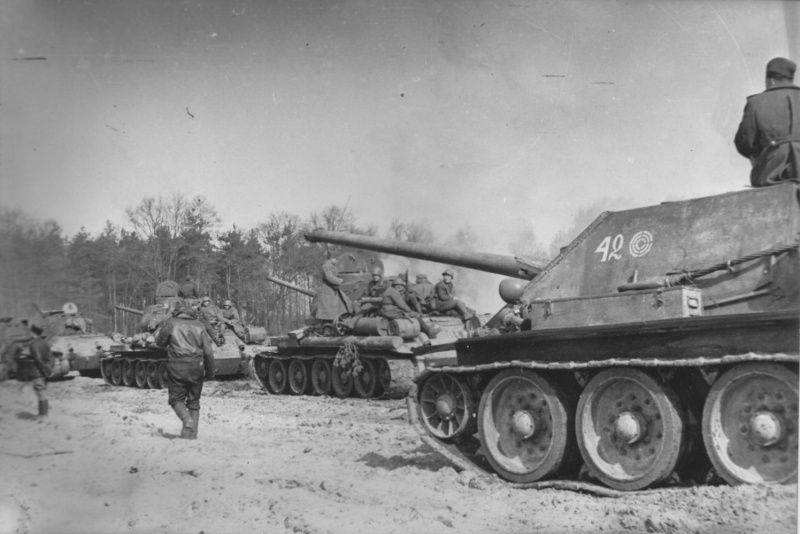
A column of Soviet T-34-85 tanks from the 9-th mechanized corps of the 3-th Guards Tank Army with armored infantry awaiting a march.
In the foreground to the right is a SU-85M self-propelled artillery mount.
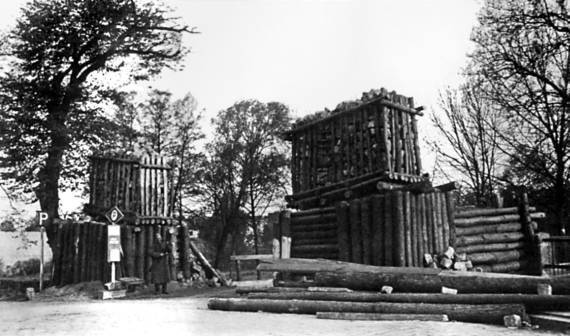
Barricade of special construction on the outskirts of Berlin. In the event of a breakthrough of the Soviet tanks, the construction of their logs and the ground in the upper part of the barricade, by undermining special charges, overturned and blocked the passage
18 April. On this day, the fighting was especially fierce. The Germans introduced new reserves into the battle and by all means tried to detain our troops at the rear line of defense. The troops of the 3 Guards Army completely took Forst and forced the Fliss Channel. As a result, the army broke through the enemy’s second line of defense on the Fliss Channel and went out to the Spree River.
The 13 Army, supported by the 3 Army Guards Tank Army, continued its offensive at night, pushing the enemy’s rear guards to the Spree. In the afternoon, the army of Pukhov beat off several fierce counterattacks of the enemy. Having established that the Germans had concentrated most of the forces and reserves in the Cottbus and Spremberg areas, the Soviet command decided to force the Spree and break through the third line of defense between these two strongholds. Between Cottbus and Spremberg, the Germans had the weakest defenses. Therefore, the main forces of the tank armies Rybalko and Lelyushenko were sent to the 13 Army band. At the same time, Soviet aviation inflicted powerful blows on the positions of the third line of defense and pulling in German reserves.
In 13 hour. On April 18, the advanced 56-I Guards Tank Brigade of the 7-Guards Tank Corps forced the Spree in the area of Brezinhen. By evening, the main forces of the corps were already on the other side. In the second half of the day, Konev personally went to the area, and made the decision to carry out the 6 Guards Tank Corps, transferred from Katlov, Zergen, through this crossing. The second echelon of the Rybalko army, the 9 mechanized corps, was sent to the same area.
7-th Guards Tank Corps with infantry 102-Infantry Corps wedged into the enemy’s third line of defense by 4 km and by the end of the day advanced to 12 km, reaching Gross-Osnig, Dobbern. The swift attack of our tankers, who quickly crossed the river and captured the bridgehead on the west bank of the Spree, did not allow the Germans to use the 344 Infantry Division, which they did not manage to bring to the third position. The troops of the 27 Infantry Corps and the 10 Guards Tank Corps achieved great success. They also forcedly crossed the Spree in the Bilov area and broke through the enemy’s third defense zone 5 km in depth. By the end of the day, our troops reached the line of Klein-Bukov, Gross-Bukov, having advanced 13 km in one day. The second echelon of the Lelyushenko tank army, the 5 Guards Mechanized Corps, was sent to the Bilov area.
Thus, the armies of Pukhov, Rybalko and Lelyushenko successfully crossed a large water line - the Spree and captured a bridgehead to the width of 10 km and depth to 5 km. Prerequisites were created for the further development of the offensive and the maneuver of mobile units on Berlin. The rapid actions of the engineering troops, which ensured the laying of bridges across the Spree, ensured the timely transfer of the main forces of the front attack force to the west bank of the river. By the end of 18 April, the sappers erected four bridges.
5-I Guard Army of Zhadov with the 6-th Guards Mechanized Corps 18 of April took a strong point of Trebendorf and the northern part of Weiswasser. Developing the offensive in the difficult conditions of a continuous forest, the Soviet troops reached the Spree and began the battle for the enemy’s major defense unit - Spremberg. Troops of the center - 34-th Guards Rifle Corps crossed the Spree and Klein Spree rivers, broke through the third line of defense of the enemy.
In the Dresden sector, Polish troops, overcoming difficult terrain and numerous obstacles, in the course of a stubborn battle took Nishki’s large defense unit. The 2 Army of the Polish Army advanced 9 km and completed the breakthrough of the enemy’s second line of defense. The 1 th Polish General Kimbar tank corps advanced in the general direction to Bautzen and detached themselves from the infantry on 5 km. By the end of the day, Polish tankers took the city of Förstgen and fought for Ober und Nieder-Elsa. On the same day, the 1 th Guards Cavalry Corps of Baranov was introduced into the breakthrough, which broke away from the infantry for several kilometers. The right flank of the 52 Army with the 7-th Guards Mechanized Corps took Weissenberg and, without meeting any special resistance, he advanced 20 km in a day. The left-flank divisions of the 52 Army waged heavy battles all day long with the 1-th Parachute Tank Division “Hermann Göring” and the enemy’s infantry. The Germans were able to press our troops on 3-4 km.
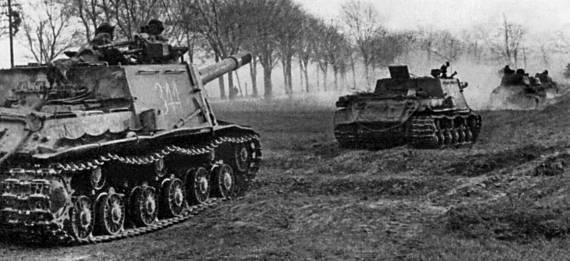
ISU-152 on the march. 1-th Ukrainian Front, April 1945
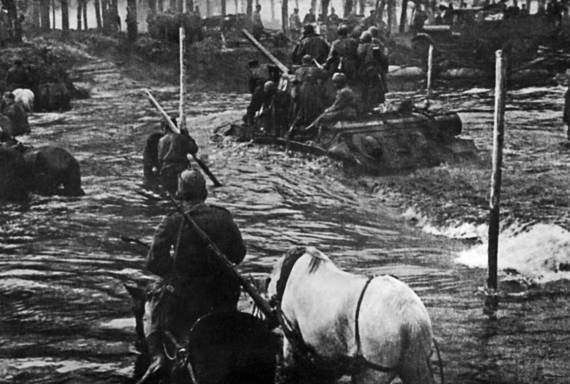
Forcing the Spree by troops 3 of the Guards. tank army. Wooden landmarks designated ford for tanks crossing the river
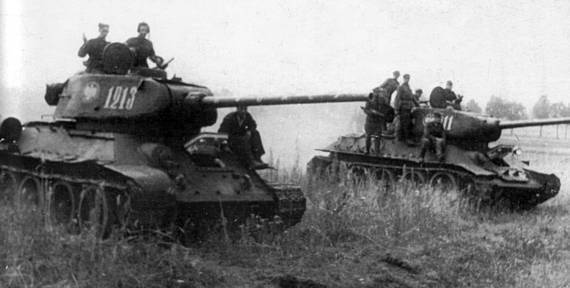
T-34-85 1 tanks of the Polish tank corps. April 1945
Results
In three days of stubborn fighting, from 16 to 18 in April, Konev's armies broke through the German army’s Neissen defensive line at the Forst-Muskau XNUM-kilometer stretch and the Steinbach-Penzich 35-kilometer stretch, and advanced westward in both directions to 20 km. Soviet troops in the area of the offensive of the main attack force of the front broke through all three enemy defense lines. The launch of the 30 and 3 units of the Guards Tank Armies on the left bank of the Spree River in the offensive zones of the 4 and 13 Guards armies allowed the command to develop an offensive to the west of the Elbe and proceed to maneuver towards the German capital.
The German 4-I tank army suffered a serious defeat and with two blows of the 1-th Ukrainian Front (the main strike group and auxiliary grouping) on Spremberg and Bautzen was divided into three separate parts: the Cottbus grouping, the troops defending in the Muskuer Forst forest area, and the Görlitz grouping. Several German divisions, including the Brandenburg motorized division, were completely defeated.
The German command, trying to stop our troops in the second and third line of defense, brought into battle from the reserve of the 3 tank army, Army Group Center and the reserve of the main command of 11 divisions, including the 5 tank and 1 motorized (21-I, 20- I armored divisions, the Fuhrer’s Guard Division, the SS Frunsberg Tank Division, the Frunsberg SS Tank Division, the Hermann Goering Parachute Tank Division, and the German Göring Parachute Motorized Division, 10.
The massive use of artillery and tanks provided the infantry with favorable conditions for the offensive. The entire 30-kilometer strip of the Neisen defensive line was broken through by the efforts of the rifle corps of the first echelon supported by the tank and mechanized corps of the first echelons of the tank armies. Rifle corps of the second echelons of combined-arms armies were not introduced into battle. The second echelons of the 3 and 4 guards tank armies remained unused. This ensured the swiftness of the further advance and maneuver. As a result, the expediency of entering the first echelons of tank armies into battle from the first day of the operation was confirmed by the course of events. The strike grouping of the front broke through three enemy defense lines and repulsed 11 counterattacks of the enemy reserve divisions.
A large role in the success of the operation was played by the engineering troops and aviation. Soviet planes smashed enemy strongholds, attacked German reserves. 18 April, the main efforts of the Soviet air army were aimed at the destruction of the main enemy resistance centers on the Spree River - Cottbus and Spremberg. On the whole, on April 16-18, the 2-I air army made more 7500 sorties and destroyed German planes in 155 air battles.
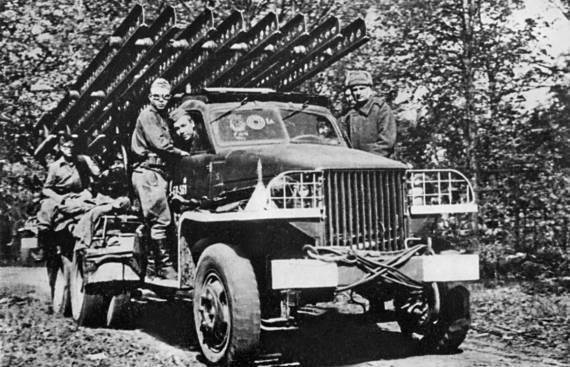
Installation of jet mortars on the Studebaker chassis on the march. 1-th Ukrainian Front, April 1945
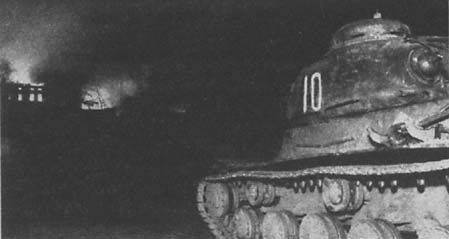
Tank IS-2 in the night battle of Spremberg
To be continued ...
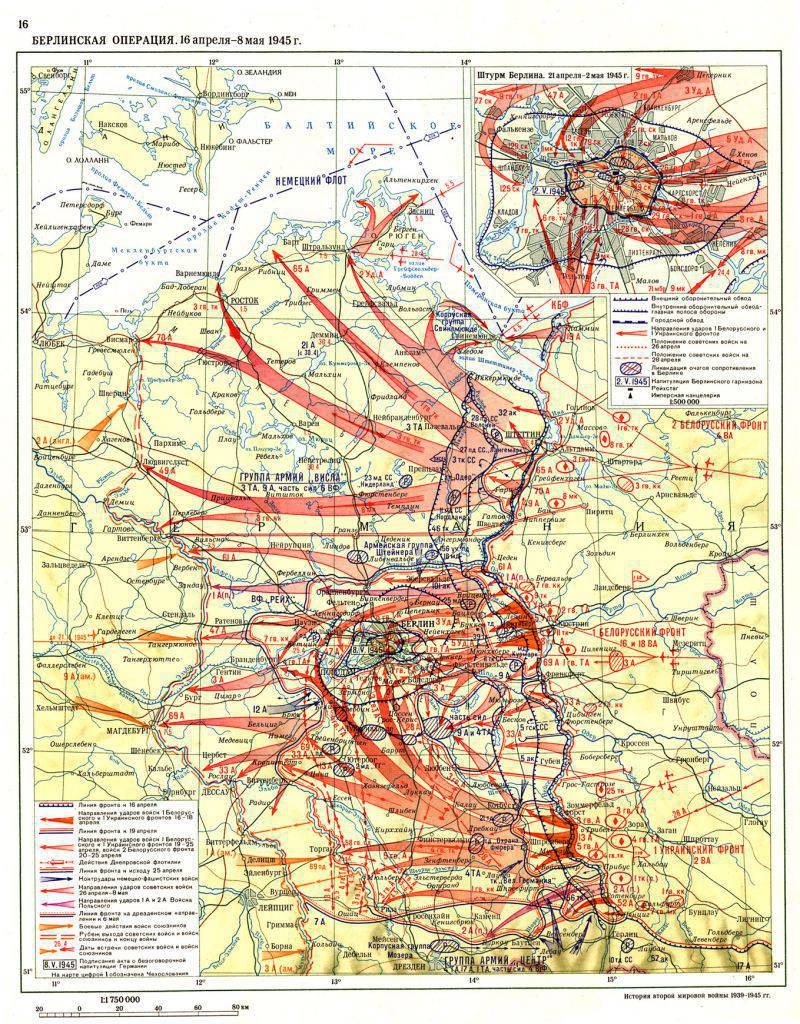
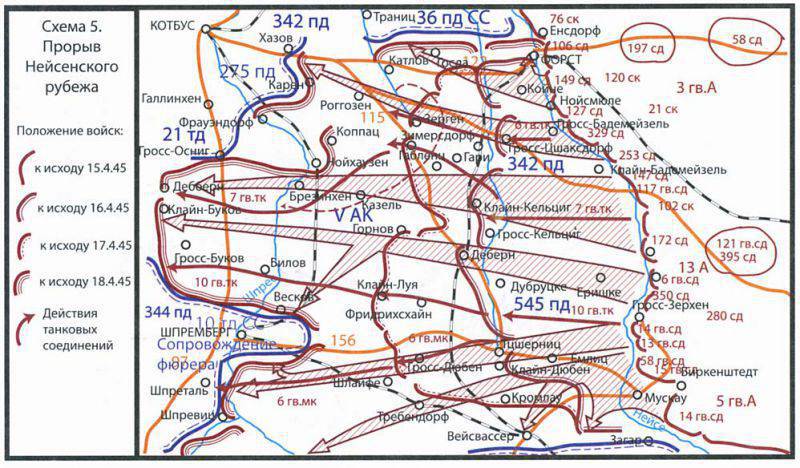
Information